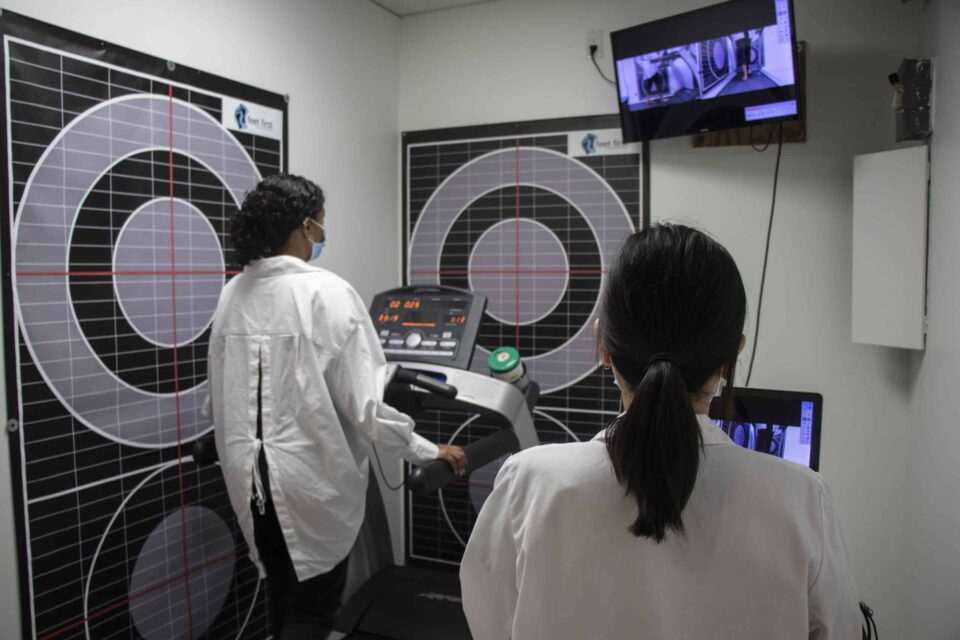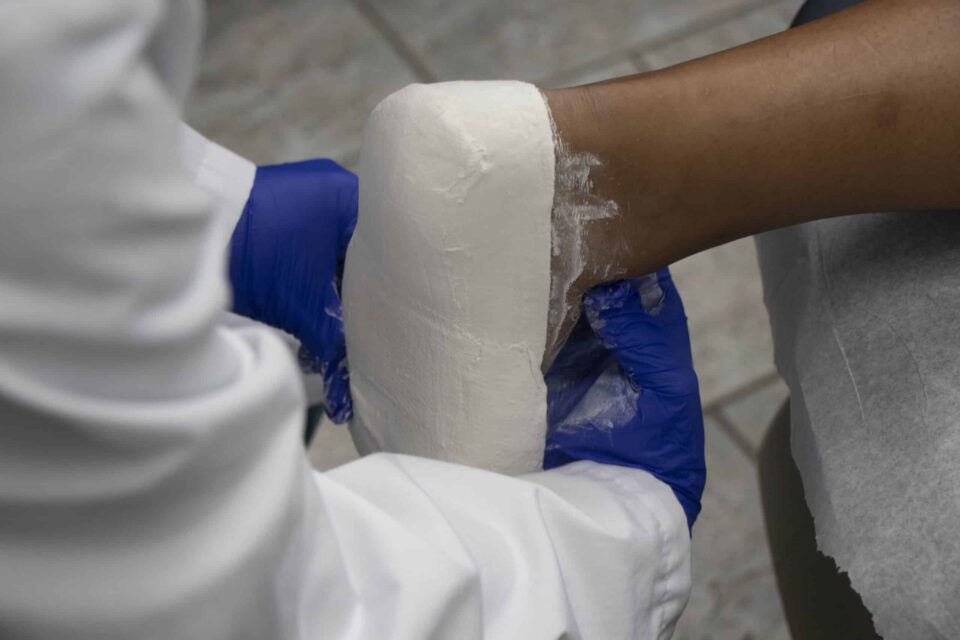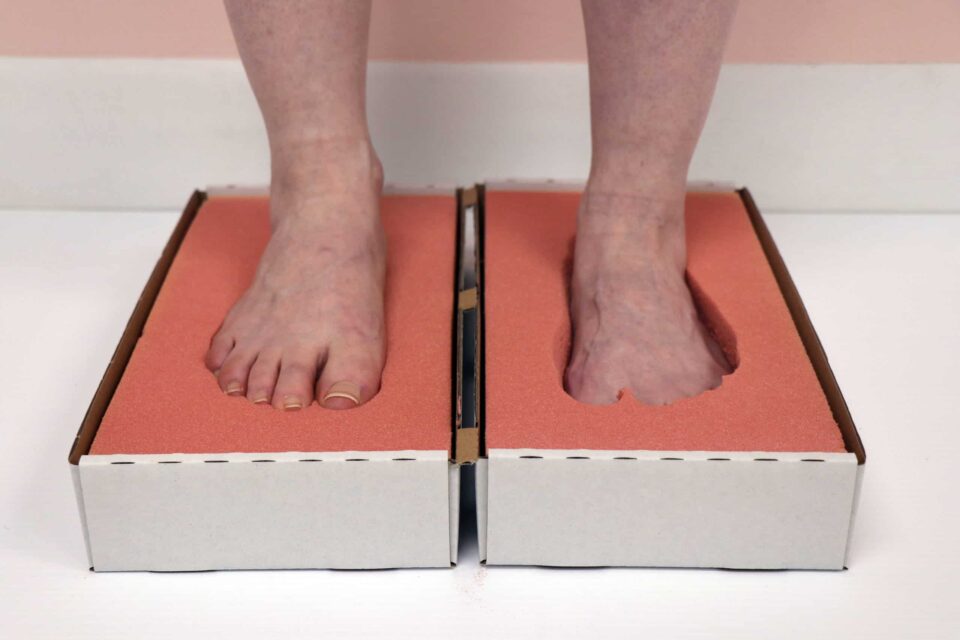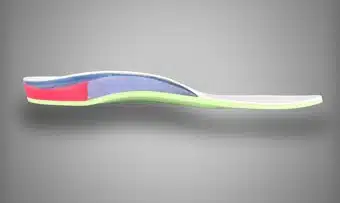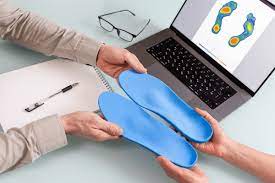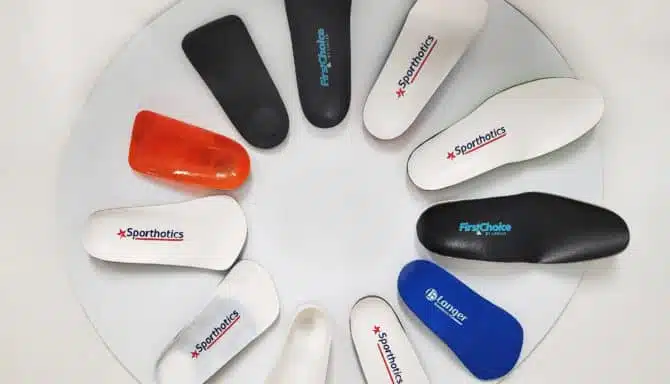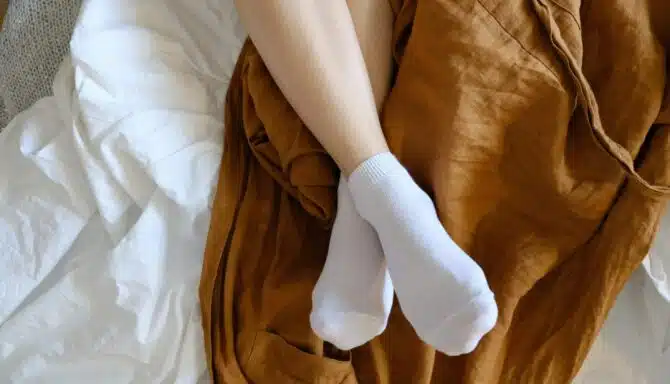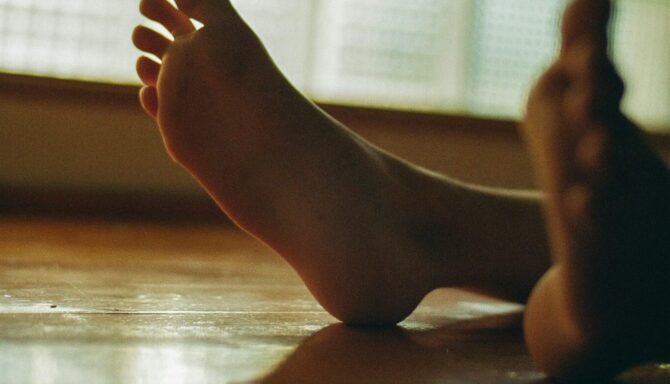October 7, 2024
Many people don’t know what goes into their custom orthotics – not just the materials, but the technology that creates a comfortable orthotic. In this post, learn about all the different accomodations and orthotic customizations available to make your feet happy!
https://www.youtube.com/shorts/IBXAXoUouFY?feature=share
What Are Orthotic Customizations and Accomodations
Additions and Accommodations are very common parts of custom orthotics. They are used if a normal over-the-counter insole just won’t cut it. For example, if a patient has a neuroma or a misaligned gait, an orthotic without custom support won’t have anywhere near the same effectiveness. Here is a list of the most common orthotic customizations and accommodations for custom orthotics.
Heel Modifications
Firstly we have heel modifications. These are some of the most common additions to keep your feet comfortable and supported:
Cushion – Adds additional padding and shock absorption on the heel. Heel cushions cover the whole heel. Cushioning the heel is helpful for a variety of foot conditions, like plantar fasciitis and arthritis. It essentially reduces the strain and impact of your step.
Lift – Heel lifts can balance out differences in leg height and to prevent overpronation or supination. They can also be used to help with Achillies tendonitis. They're made of a harder material for balance.
Hole – Heel holes are used to help with heel spurs. Cushioning can be added to increase comfort and distribute pressure in the heel.
Seat – A Heel seat gives the patient more control if they overpronate. It's designed to hold the fatty tissue under the calcaneus in place.
Metatarsal Modifications
These orthotic customizations are designed to take pressure off of your metatarsals (the ball of your foot). They are helpful for anyone experiencing foot pain at the ball of their foot just below the toes.
1st Ray Cutout - Helps to offload pressure off 1st metatarsal head (the big toe). This is used to help with bunions and arthritis.
2-4 Metatarsal Pad – This is a teardrop shaped pad that sits below the metatarsals. It takes some of the load off the metatarsals by offloading pressure at ball of foot and elevating the second, third, and fourth metatarsals.
Metatarsal Bar – This is similar to 2-4 metatarsal pads, but has more surface area and offloads more pressure from the metatarsal heads. It can provide more stress relief in some cases.
Neuroma Pad – This is a small pad that sits between metatarsals and spreads them apart. It is designed to correct the transverse arch and help with pain in the metatarsals. As the name suggests, it is can help people experiencing a Morton's neuroma.
Arch Support
Moving on, we have arch support, which is important for everyone - regardless of whether you have a foot condition - but moreso for people who struggle with plantar fasciitis and arch pain.
Arch Pad – Additonal support on the arch for patients who need more arch support.
Fill – Arch fills make the orthotic more rigid. This is used to help the orthotic to support more weight. It can also be used to help somewhat with controlling the midtarsal joints.
Additional Accommodations
Finally, we have modifications that don't really fit into the previous categories. These are all very common additions that are often put in orthotics:
Morton’s Extension – Extra length under 1st metatarsal to keep it rigid. It helps during the push off phase of gait and can be rigid if patient has hallux rigidus or limitus. It immobilizes and offsets pressure on the first met joint.
Reverse Morton’s – This increases the mobility of the first met joint. The pad sits under the 2nd to the 5th met head and ends before the first.
Dancer Pad – Offloads the ball of the foot. It works by taking weight off of the big toe joint and dispersing it.
Scaphoid Pad - This is used to help support the mid and back foot. Helps take pressure off the joints and bones in the arch.
While these are the most common accommodations found on orthotics, there are many more! To learn more about how orthotics can be modified and customized to suit your unique foot needs, check out this Website.
What Orthotic is Right For Me?
A licensed chiropodist can determine what orthotic customizations and features are best for you. The chiropodist would first do a biomechanical assessment and gait analysis. They'll then diagnose your foot condition and make recommendations. Remember - orthotics are just one part of the equation when it comes to treating foot pain. While they can be beneficial for many common foot conditions, it's recommended to also explore other treatment options first, like supportive footwear, exercises and stretches.
If your chiropodist recommends orthotics, they'll discuss the different options and customizations available, and which ones will work best for your foot condition. They'll also take into account your activities and the footwear you'd be wearing the orthotics with. The chiropodist will then take a 3D scan of your foot and send it off to the lab to make your orthotics. You would then see the chiropodist a few weeks later for a fitting appointment, at which time the chiropodist will check that the orthotics are constructed properly and working the way they should. If everything checks out, you can take them home! We also recommend coming back about 6 to 8 weeks after your fitting for a follow-up appointment to see if your orthotics are helping with your foot pain. If they aren't, the chiropodist can modify the orthotics.
https://www.youtube.com/shorts/pO5oWb6S5MA?feature=share
September 26, 2024
Orthotics are supportive, custom devices designed to improve the alignment and function of the feet, ankles, and lower limbs. They aim to address specific issues like flat feet, overpronation, or arch support. This can help alleviate discomfort and prevent injuries by redistributing pressure and correcting abnormal movement patterns. Adequately fitted orthotics can significantly enhance comfort and mobility, making daily activities more manageable and pain-free.
Custom orthotics can make a big difference, but how exactly do orthotics correct foot alignment? And how do they work? Let's explain.
What are orthotics?
Orthotics are specialized, custom-designed insoles that you place inside your shoes. They come in many forms, and are molded and constructed specific to your unique foot needs. Their main job is to support and correct the alignment of your feet, which can help address various foot and lower limb issues. They essentially promote healthy biomechanics to ensure your body moves the way it's designed to.
Orthotics are custom-made specifically for your feet by a chiropodist (foot specialist). The chiropodist will do a biomechanical and gait analysis, and then take a mold of your foot (typically with a 3D digital scanner). The chiropodist then custom-designs the orthotics according to your specific needs, and a lab then constructs the orthotics according to the chiropodist's instructions.
It's important to note that while orthotics can be beneficial, they may not be suitable for everyone and can have some drawbacks, such as initial discomfort and the need for regular maintenance. Custom orthotics are more expensive than over-the-counter options, but they are an investment in your future — they may allow you to avoid more severe issues and chronic pain long-term, and can address foot concerns that over-the-counter insoles cannot. Not to mention, they are longer-lasting.
How orthotics correct foot alignment?
Orthotics are meant to modify how your foot moves and distributes pressure. They can help with several conditions, including:
Flat feet: Orthotics can support fallen arches to maintain and prop up the natural contours of your foot.
High arches: When you have high arches, excessive pressure is placed over a very small area of your foot. Orthotics help by cushioning and distributing pressure more evenly. If pressure is unevenly distributed across your feet, you're at a higher risk of overworking neighbouring parts of your foot.
Overpronation: If your feet roll inward too much when you walk or run (called "overpronation), orthotics can help correct this movement. They do this by creating a barrier to your foot's inward movement, which corrects the overpronation. (Interesting fact: people with flat feet are prone to overpronation, so the treatment for the two conditions is often the same).
Heel pain: Orthotics can reduce the strain on the plantar fascia and help alleviate heel pain.
By correcting foot alignment, orthotics can provide significant relief from pain and prevent future issues. The feet are our body's foundation, so when your feet are moving properly, it helps the rest of our body move properly. That allows muscles and joints to work the way they were designed to without being over-stressed. This then helps reduce pain - not only in our feet, but the rest of our body too!
Types of orthotics
There are many different types of orthotics designed for different footwear and activities. Click here to learn more!
Benefits beyond pain relief
Orthotics don't just help with pain—they can also play a proactive role in enhancing overall foot and body health. Proper alignment can lead to better posture, reduced knee and hip stress, and improved gait. Athletes often use orthotics to boost performance by optimizing foot mechanics, which then reduces the strain on the rest of their joints.
How to choose the right orthotics
If you're considering orthotics, here's what to keep in mind:
Consult a professional: A chiropodist can help determine if you need custom orthotics through a biomechanical assessment. They can then prescribe, design and fit your orthotics based on your activities and specific foot concerns. A chiropodist may also recommend footwear and over-the-insole options to test out first before going the custom route.
Consider your activities: Choose orthotics that match your lifestyle. For instance, if you're a runner, look for ones designed to absorb shock and provide stability. If you work in a setting with a formal dress code, you may want to opt for slimmer dress orthotics that will fit into your dress shoes.
Look at the full picture: Orthotics alone likely won't solve all your foot concerns. They're just part of the equation. You'll also want to ensure your wearing proper footwear and maintaining an active, healthy lifestyle. If you have chronic pain or a conditions like arthritis, regular exercise and stretching is very important to build strength in your feet and ankles. Orthotics are essentially meant to supplement a healthy lifestyle - not substitute it.
How to get the most out of your orthotics
Once you have your orthotics, wear them regularly to see the best results. They take some time to get used to, so gradually increase the time you wear them daily. Also, remember that orthotics are just one part of foot health—maintaining a proper exercise routine and suitable footwear are equally important. To ensure the longevity of your orthotics, clean them regularly and follow any specific care instructions provided by the manufacturer or your chiropodist.
September 23, 2024
The leaves are starting to change colour and the temperatures are taking a dip! What does that mean for your feet? A lot! Seasonal changes have a big impact on our foot health, which is why it's important to prepare your feet for fall — especially if you have a foot condition. To help you our, we compiled our Toronto foot specialists' top foot care tips for fall to keep your feet comfortable and healthy as you transition into cooler days. From selecting the right footwear to vigilant skin care, a little preparation can go a long way in keeping you cozy and supported.
Moisturizing, Skin Care and Protection
We all get thirsty, and the same thing happens to your skin — especially when the summer’s humidity is replaced with colder air that prevents it from retaining moisture.
One of the best ways to prepare your feet for fall is by focusing on hydrating your skin. Moisturizing your feet regularly will help you fight painful issues, like cracked heels. Incorporate a rich foot cream, like Gehwol’s Salve for Cracked Skin, if you notice dry cracks in your heels.
For a more preventative approach, moisturize every day to lock in moisture and keep your skin soft, and then exfoliate to remove dead skin cells. This lets the moisturizer penetrate deeply. Try the universally beneficial Soft Feet Cream from Gehwol; it binds moisture to the deepest layers of the skin and strengthens its natural defence. Learn more with our comprehensive moisturizing guide.
Fall Shoe Tips and Supportive Fall Footwear
Cold air can exacerbate foot pain by messing with your blood circulation. Healthy shoes can help offset this and make a world of difference.
Look for cozy fall boots, ideal for everyday wear. These include ankle boots with sturdy soles, a solid grip to prevent falls, good arch support, and cushioning. Additionally, consider shoes made from waterproof materials, like Gore-Tex fabric, to protect against the elements. Not only will this help with fall foot comfort, but it will also keep your feet dry and warm as the weather cools down. Damp feet can cause issues like infections and foot odour.
For those extra cold days, you should wear boots with soft materials, like fleece or shearling, for insulation against the cold. You never know when the snow falls and below-zero temperatures will begin, so having a pair of boots like this ready to wear is always wise.
Lastly, your fall shoes might work even better if you wear them with custom orthotics or high-quality Superfeet insoles. Ask your chiropodist if they can help you.
Our Toronto foot clinic is known for our excellent shoe shopping tips, particularly for the fall and winter. We can also provide a complimentary shoe fitting service for when you don’t know where to start with your fall shoe hunting.
Foot Conditions Requiring Extra Care in Fall
If you have arthritis or diabetes, fall foot care is even more important. That's why one of our top fall foot care tips is to pay close attention to your foot health and regularly visit your chiropodist so they can keep an eye on your feet - especially if you have vulnerable feet.
Arthritis sufferers may find that the cold exacerbates joint stiffness and pain. The lower temperatures can cause muscles to tighten, putting additional strain on already sensitive joints.
For people with diabetes, the reduced blood circulation can be extra dangerous and worsen the body’s already compromised healing abilities. Ulcers, infections and even frostbite can be big problems during the chilly months.
September 16, 2024
You may have heard of custom orthotics before, (if not, check out this article) but did you know that there are many different types of custom orthotics? Orthotics range from sports orthotics to dress orthotics, and everything in between. In this article we will cover the different types of custom orthotics you can choose, and what might be best for your feet.
Custom Orthotics
Custom Orthotics are the most common type of orthotic. Easily accessible and slipped into shoes, these provide maximum support and can help with foot problems like plantar fasciitis or Morton’s neuroma. Custom orthotics are also ideal simply if you want more comfort and support when walking around during everyday tasks. All of the orthotics below are some kind of custom orthotic. You can also find many examples of these orthotics on this website.
Sports Orthotics
These orthotics are ideal for people who are often running, jumping, and doing high impact activates on a regular basis. Sports orthotics can be easily modified to fit the sport you're doing. For example, if you were a basketball player who Is doing lots of jumping, the orthotic would be made with extra shock absorption. Sports orthotics are designed to help with common sports conditions like plantar fasciitis. They are made semi-rigid to provide the optimal balance between comfort and control.
Casual Orthotics
If you enjoy going on walks but often have pain in your feet, casual orthotics may be the way to go. These orthotics are meant for walking and standing for long periods of time and can provide comfort that you may not otherwise get from your regular shoes. Casual Orthotics are also great because they are easy to transfer between shoes and are low profile, meaning they're relatively, so you can wear them with shoes that don't have removable insoles. Casual orthotics are typically rigid or semi-rigid depending on your foot condition.
Dress Orthotics
Like casual orthotics, dress orthotics are meant for long periods of standing and walking. The main difference between the two is the size. Dress orthotics are designed to be slimmer and fit into the smaller shape of dress shoes. Because of the limited space, some orthotics may have to sacrifice width and support; however they will still provide relief from uncomfortable shoes.
Accommodative Orthotics:
Accommodative orthotics are designed for people that have more severe issues with foot pain and comfort. This can include arthritis, foot deformities, and diabetes. They tend to have a soft and cushioned top cover. These orthotics are mostly flexible to be nicer on the feet, however they can also be semi-rigid if the user needs more control.
Children's Orthotics
Childrens orthotics differ from adults because children are growing constantly. Often, children are prescribed orthotics to correct an issue that would be present in their adult life if not corrected. Children may get several different pairs of orthotics as they grow older to accomodate their changing feet. Children's orthotics are made for comfort as well as correction, so that your little one can be comfortable running around.
Conclusion
There are many different types of orthotics available that can easily accomodate your footwear and activities. They're also a great way to upgrade your favourite shoes. Whether you want comfort or control, there is always an option for you.
September 12, 2024
Looking to end your stint with foot arch pain? You've come to the right place. This post explores different kinds of arch pain, what causes it, and our top tips for foot arch pain relief.
Plantar fasciitis
Plantar fasciitis occurs when the plantar fascia (the thick band of tissue running along the bottom of your foot) becomes inflamed. It typically causes sharp pain in the heel and arch, especially in the morning or after periods of rest.
Cause: Repeated stress on the feet, especially from high-impact activities, can strain the arch and lead to pain. Increased body weight can also stress the feet more, leading to arch pain and discomfort. Finally, shoes lacking adequate arch support or cushioning and poorly fitted shoes can exacerbate foot pain.
How to alleviate pain: Rest, recovery and ice are the first things you should do to alleviate plantar fasciitis. The next step is to invest in footwear with proper arch support and cushioning. You can also upgrade your existing footwear with insoles or orthotic inserts designed for arch support. Custom orthotics help redistribute pressure in your foot and reduce strain on the arch. Stretching exercises for the Achilles tendon and plantar fascia can also reduce inflammation and arch pain associated with plantar fasciitis..
High arches
People with high arches often experience discomfort in the arch and heel due to insufficient shock absorption. This condition can lead to an imbalance in foot mechanics, causing pain in various parts of the foot.
Cause: Genetic factors can play a role in high arches.
How to alleviate pain: Cushioned, supportive shoes and insoles can help manage arch pain associated with high arches. Look for footwear with ample cushioning and arch support to alleviate discomfort.
Flat feet
Also known as fallen arches, flat feet affects the arch's ability to properly support a person's body weight, which then leads to arch pain. Flat feet can cause many biomechanical issues, which can lead to overpronation (where the foot rolls inward excessively), plantar fasciitis, and many other foot conditions, all of which contribute to foot and ankle pain.
Cause: Like high arches, genetic factors can play a role in flat feet. Flat feet can predispose individuals to certain types of foot pain.
How to alleviate pain: Proper arch support is key for foot arch pain relief. People with flat feet should look for stability shoes. These shoes are specially designed to correct overpronation and properly support the arch. Custom orthotics can also significantly support fallen arches. They're tailored to your foot's needs and help improve alignment and pain. You can get custom orthotics at our foot clinic by booking an Orthotic Assessment appointment with one of our licensed chiropodists.
August 29, 2024
Plantar fasciitis, a condition that impacts the foot and the heel, is very common but often misunderstood. If you've felt sharp stabbing pain in your heel when you take your first steps in the morning, you might know this condition firsthand. But what does plantar fasciitis mean, and how can you treat it? Let's explore the specifics to help you better understand plantar fasciitis causes and treatments.
What is plantar fasciitis?
Plantar fasciitis happens when the plantar fascia gets inflamed. This thick band of tissue stretches from your heel to your toes along the bottom of your foot. It helps support your foot's arch and handles the stress we put on our feet. When this band gets irritated or swollen, it can lead to pain and discomfort. You'll often feel this pain in your heel area.
Causes of plantar fasciitis
Plantar fasciitis is typically caused by overuse and activities that put too much stress on the feet, which ultimately strains the plantar fascia. Such activities include includes running long distances, standing for hours, or playing high-impact sports. Risk factors that can make you especially vulnerable to developing plantar fasciitis include:
Foot structure: Conditions such as flat feet or high arches can lead to unhealthy biomechanics (i.e.: overpronation), which can then can put extra stress on the plantar fascia when you walk.
Improper footwear: Wearing shoes that don't support or cushion your feet well can make you more likely to develop plantar fasciitis. High heels, old shoes, or flimsy footwear without adequate arch support can all contribute.
Getting older: Those aged 40-60 are more prone to plantar fasciitis, but it can happen to anyone at any age. It's one of many age-related changes to the feet we experience as we age.
Your job: Working a job where you have to stand or walk on hard floors for a long time can increase your chances of getting this condition. That's right! Even your career can influence your foot health.
Symptoms of plantar fasciitis
The telltale symptom of plantar fasciitis is heel pain. In addition, you may experience the following:
Quick-hitting pain: Pain is often most severe when you take your first steps in the morning, or after sitting for an extended period. This pain tends to decrease with continued activity but can return after rest.
Sharp pain: Plantar fasciitis-related pain is typically sharp and may be felt near the heel's underside.
Pain post-exercise: While activity may initially relieve the pain, it can worsen after exercise or at the end of the day.
Tenderness: Pressing on the area where the plantar fascia attaches to the heel bone may cause pain.
Treating plantar fasciitis
You may experience pain with plantar fasciitis first thing in the morning.
The good news is that most cases of plantar fasciitis can be managed with conservative treatments. Here are some effective strategies for treating plantar fasciitis:
Rest and ice: Resting and applying ice to the affected area can help reduce inflammation and pain. Aim to ice your heel for 15-20 minutes several times daily. You may also benefit from over-the-counter anti-inflammatories like ibuprofen or naproxen, which can reduce pain and inflammation.
Stretching exercises: Gentle stretching of the calf muscles, Achilles tendon, and plantar fascia can help alleviate tension and reduce pain. Exercises such as the calf stretch, towel stretch, and rolling the foot over a cold bottle or a tennis ball can be beneficial.
Footwear: Wear supportive shoes with good arch support and cushioning. Avoid walking barefoot on hard surfaces, and consider using custom orthotic inserts to provide additional support. Read our dedicated blog post on the best shoes for plantar fasciitis.
Night splints: Wearing night splints can help keep the plantar fascia stretched overnight, which may reduce morning pain.
Avoid high-impact sports and activities: Temporarily reducing or modifying activities that exacerbate your symptoms can help prevent further irritation of the plantar fascia.
